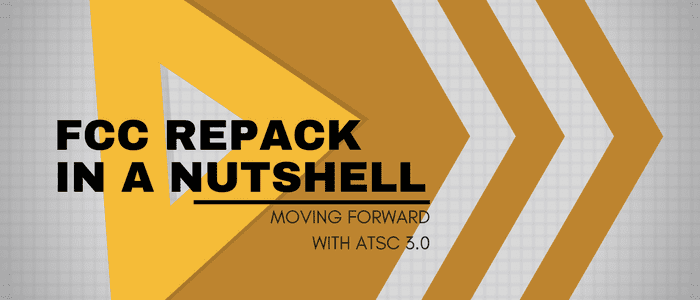
By Doug Thompson, Hitachi-Comark TV
We have been anticipating the effects of the FCC Incentive Auction “repack” for five years now. It’s finally here. The auctions are over, the 399’s have been turned in and the channels have been changed. But now… we continue to wait. Here’s why:
Repack is currently in “Phase 0”: The FCC has allocated all the new RF channels
- Broadcasters have submitted their documentation
- Construction Permits have been issued by the FCC
- The FCC is reviewing individual DTV station repack plans and associated budgets (Schedule 399)
However, the FCC’s Repack Fund is short:
- FCC originally estimated $1.75 billion to cover the repack
- Broadcasters submitted budgets totaling $2.139 billion
- Careful review of 399’s reduced total budget to $1.864 billion
- FCC notified broadcasters on Oct. 15, 2017 that they will:
- Release $1 billion of the fund for immediate use
- But, hold back $750 million, which means
- Broadcasters will have access to only 52 percent of their submitted repack expenses budget
- To facilitate an orderly repack of roughly a thousand stations, the FCC assigned each station to one of 10 phases.
- Each phase has about 100 TV stations. The table below shows the dates for each state of the 10 phases.
| Phase | Phase Start Date | 399 Due To FCC | Testing Begin Date | Phase Complete Date |
|---|---|---|---|---|
| One | 4/13/2017 | 7/12/2017 | 9/17/2018 | 11/30/2018 |
| Two | 4/13/2017 | 7/12/2017 | 12/1/2018 | 4/12/2019 |
| Three | 4/13/2017 | 7/12/2017 | 4/13/2019 | 6/21/2019 |
| Four | 4/13/2017 | 7/12/2017 | 6/22/2019 | 8/2/2019 |
| Five | 4/13/2017 | 7/12/2017 | 8/3/2019 | 9/6/2019 |
| Six | 4/13/2017 | 7/12/2017 | 9/7/2019 | 10/18/2019 |
| Seven | 4/13/2017 | 7/12/2017 | 10/19/2019 | 1/17/2020 |
| Eight | 4/13/2017 | 7/12/2017 | 1/18/2020 | 3/13/2020 |
| Nine | 4/13/2017 | 7/12/2017 | 3/14/2020 | 5/1/2020 |
| Ten | 4/13/2017 | 7/12/2017 | 5/2/2020 | 7/3/2020 |
Low Power operators with no class A assignment are sadly left out of the FCC refund agreement completely. The FCC refused to give the same primacy to Low Power that it gave to High Power. Except for having a date when you can change your channel and move to where you will (hopefully) stay, it seems this article offers very little in good news for LPTV.
If you are in the LPTV category, there is some good news for you. ATSC 3.0 is your future. It offers more than just the same old broadcasting (we will talk more about that in future issues). The important thing is not to wait until the very end of the phases to get new transmitters, antennas and engineering crews.
Nearly everyone expects this to take longer than the FCC has allowed, but the expectation is not reality, yet. The FCC says they would be willing to grant more time, but not until it is clear more time is necessary. Yet, stations in Phase one and two, and in some cases from stages three and four as well, are making an effort to either stay ahead of the timeframe or meet a tighter timeframe set out by Mobile One.
The capabilities of Next Gen TV are very exciting and early preparation and implementation will be key to meeting or exceeding the FCC’s proposed timeline. The future is very bright whether you are High Power, Class A, or LPTV.